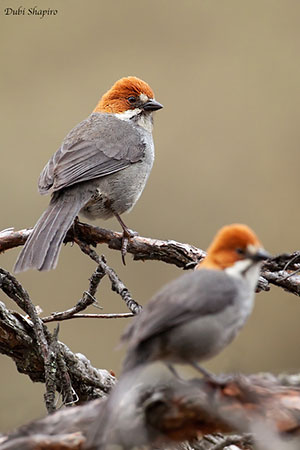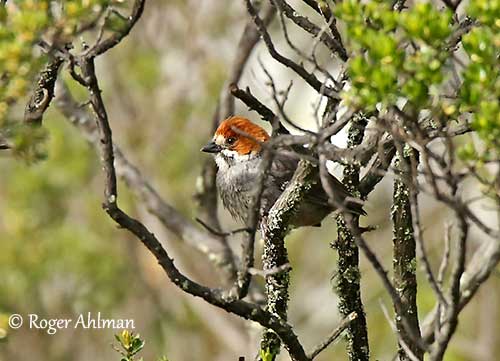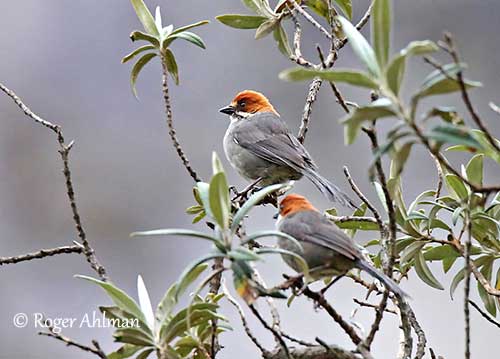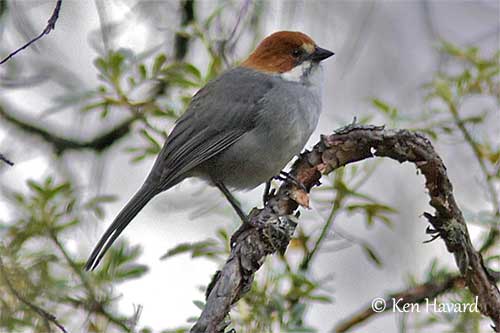
Fr: Tohi rougeaud
Ang: Rufous-eared Brush-Finch
All: Rotohr-Buschammer
Esp: Atlapetes Orejirrufo - Matorralero de Oreja Rufa (Pérou)
Ita: Fringuello di macchia guancerossicce
Nd: Roodoorstruikgors
Sd: brunhuvad snårsparv
Photographers:
Roger Ahlman
Pbase Galleries Peru and Ecuador
Ken Havard
My Bird Gallery & Flickr gallery 1 & Flickr gallery 2
Dubi Shapiro
Dubi Shapiro Photo Galleries
Text by Nicole Bouglouan
Sources:
HANDBOOK OF THE BIRDS OF THE WORLD Vol 16 by Josep del Hoyo- Andrew Elliot-David Christie – Lynx Edicions – ISBN: 9788496553781
BIRDS OF SOUTH AMERICA – Passerines - by Robert S. Ridgely and Guy Tudor – HELM Field Guides – ISBN: 9781408113424
BIRDS OF PERU by Thomas S. Schulenberg, Douglas F. Stotz, Daniel F. Lane, John P. O’Neill, Theodore A. Parker III –Princeton University Press 2007– ISBN: 978-0-691-13023-1
Neotropical Birds – Cornell Lab of Ornithology
Rufous-eared Brush-Finch
Atlapetes rufigenis
Passeriformes Order – Passerellidae Family
INTRODUCTION:
The Rufous-eared Brush-Finch is endemic to Peru where it is found on both east and west sides of the upper Marañon River Valley. It frequents dense shrubbery and undergrowth of montane woodlands, between 2,800 and 4,300 metres of elevation. The diet is poorly known, but it probably feeds on seeds and insects, according to the season.
The Rufous-eared Brush-Finch is threatened by habitat destruction throughout the range, and by degradation caused by human activities. The species is currently listed as Near Threatened.
DESCRIPTION OF THE BIRD:
Biometrics:
Length: 18,5-19 cm
Weight of one male: 40-44 g
The Rufous-eared Brush-Finch has grey upperparts slightly tinged olive. Upperwing and tail may appear darker.
On the underparts, the throat is white. Breast and flanks are greyish, but belly and undertail-coverts are whitish.
The large head is rufous, including nape and neck sides. The area in front and below the eye is dark greyish, whereas the supraloral area is white. A long, white submoustachial stripe and a narrower blackish malar stripe contrast with the bright rufous of the head.
The conical bill is black. The eyes are reddish-brown. Legs and feet are dark brown.
Male and female are similar.

The juvenile is duller with grey-brown crown. The white loral spot is present.
The grey upperparts are tinged brown. The throat is white. Breast and body sides are dark brown but the belly is whitish.
RANGE:
The Rufous-eared Brush-Finch is found in the Andes of N Peru, and especially in the upper Marañon River Valley, from Cajamarca S to Ancash and Huánuco.
HABITAT:
The Rufous-eared Brush-Finch frequents Polylepis and Gynoxys woodlands and dense humid shrubbery, between 2,800 and 4,300 metres of elevation.

CALLS AND SONGS: SOUNDS BY XENO-CANTO
The calls of the Rufous-eared Brush-Finch include high-pitched “ti” and tsi”.
During the breeding season, both mates make duets consisting mostly of low chatters and some high, lisping notes.
BEHAVIOUR IN THE WILD:
The Rufous-eared Brush-Finch probably feeds mainly on seeds and insects, according to the season.
They usually forage in pairs on or near the ground, between 50 centimetres and 1,50 metre, rarely higher. They search for food in the undergrowth of Polylepis and Gynoxys woodlands, along the branches covered with moss.
Information is needed about the breeding behaviour, but the species is suspected to be socially monogamous. The pairs do not join mixed-species flocks.
We can suggest that the bright-coloured head pattern is displayed during the courtship behaviour.
The Rufous-eared Brush-Finch is resident and only performs short-distance flights.

REPRODUCTION OF THIS SPECIES:
Juveniles were observed in June in La Libertad, and in February/March in Ancash.
The members of genus Atlapetes usually build a cup-shaped nest with grasses and plant fibres. It is suspected to be built by the female alone, as she incubates alone too. However, the chicks are fed by both parents.
More information is required.
PROTECTION / THREATS / STATUS:
The Rufous-eared Brush-Finch has restricted range in which it is described as uncommon to locally fairly common.
The species is threatened by destruction of the habitat caused by deforestation, cutting for firewood, burning and intensive grazing. Soil erosion is caused by intensification of agriculture and road-building. Inadequate afforestation projects, with the planting of Eucalyptus and other exotic plant species, are also important problems.
But conservation of Polylepis forest is active.
The population is declining due to the previous threats.
The Rufous-eared Brush-Finch is currently listed as Near Threatened.
